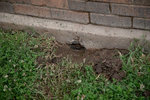



While wind, hail and tornadoes are often considered the primary threats with thunderstorms, lightning is often a forgotten one.
That will likely not be the case for a while for the staff and board members of the Freedom Museum USA in Pampa.
The night of May 17, a thunderstorm with a lot of lightning blew threw Pampa and struck just behind the Huey helicopter at the Freedom Museum, driving a seven-foot hole into the ground at the former water pump station.
“The lightning hit a power-line near it and blew a seven-foot hole underneath the Huey,” Freedom Museum USA Board Member Della Moyer said. “It lifted the tank and tracked-personnel carrier off of the ground.”
The blast from the lightning knocked a hole in the foundation and created a raised spot inside of the building. On a minor scale, it melted a suspension cable that had been used for one of the blades to the Huey helicopter.
Assistant Curator RJ Howell, who lives a mile away from the museum, said it sounded like “a plane had crashed nearby.”
“I heard it and I’m pretty sure every one in town heard it,” Howell said. “I have a pretty solid foundation and my windows rattled quite a bit.”
The lightning strike also caused the power at the museum to go out and fried many of the electronic devices.
“It fried all of the security and electronics in the building,” Moyer said. “When I went in there to get ready for the field trip we had coming that day it was dark and every alarm in the building was screaming.”
The following are some tips, myths and facts about lightning (from the National Weather Service) to keep in mind as severe weather season continues:
Myth: If you’re caught outside during a thunderstorm, you should crouch down to reduce your risk of being struck.
Fact: Crouching doesn’t make you any safer outdoors. Run to a substantial building or hard topped vehicle. If you are too far to run to one of these options, you have no good alternative. You are NOT safe anywhere outdoors. See our safety page for tips that may slightly reduce your risk.
Myth: If it’s not raining or there aren’t clouds overhead, you’re safe from lightning.
Fact: Lightning often strikes more than three miles from the center of the thunderstorm, far outside the rain or thunderstorm cloud. “Bolts from the blue” can strike 10-15 miles from the thunderstorm.
Myth: Rubber tires on a car protect you from lightning by insulating you from the ground.
Fact: Most cars are safe from lightning, but it is the metal roof and metal sides that protect you, NOT the rubber tires. Remember, convertibles, motorcycles, bicycles, open-shelled outdoor recreational vehicles and cars with fiberglass shells offer no protection from lightning. When lightning strikes a vehicle, it goes through the metal frame into the ground. Don’t lean on doors during a thunderstorm.
Myth: A lightning victim is electrified. If you touch them, you’ll be electrocuted.
Fact: The human body does not store electricity. It is perfectly safe to touch a lightning victim to give them first aid. This is the most chilling of lightning Myths. Imagine if someone died because people were afraid to give CPR!
Myth: If outside in a thunderstorm, you should seek shelter under a tree to stay dry.
Fact: Being underneath a tree is the second leading cause of lightning casualties. Better to get wet than fried!
Myth: If you are in a house, you are 100% safe from lightning.
Fact: A house is a safe place to be during a thunderstorm as long as you avoid anything that conducts electricity. This means staying off corded phones, electrical appliances, wires, TV cables, computers, plumbing, metal doors and windows. Windows are hazardous for two reasons: wind generated during a thunderstorm can blow objects into the window, breaking it and causing glass to shatter and second, in older homes, in rare instances, lightning can come in cracks in the sides of windows.
Myth: If thunderstorms threaten while you are outside playing a game, it is okay to finish it before seeking shelter.
Fact: Many lightning casualties occur because people do not seek shelter soon enough. No game is worth death or life-long injuries. Seek proper shelter immediately if you hear thunder. Adults are responsible for the safety of children.
Myth: Structures with metal, or metal on the body (jewelry, cell phones,Mp3 players, watches, etc), attract lightning.
Fact: Height, pointy shape, and isolation are the dominant factors controlling where a lightning bolt will strike. The presence of metal makes absolutely no difference on where lightning strikes. Mountains are made of stone but get struck by lightning many times a year. When lightning threatens, take proper protective action immediately by seeking a safe shelter – don’t waste time removing metal. While metal does not attract lightning, it does conduct it so stay away from metal fences, railing, bleachers, etc.
Myth: If trapped outside and lightning is about to strike, I should lie flat on the ground.
Fact: Lying flat increases your chance of being affected by potentially deadly ground current. If you are caught outside in a thunderstorm, you keep moving toward a safe shelter.
Myth: lightning flashes are 3-4 km apart
Fact: Old data said successive flashes were on the order of 3-4 km apart. New data shows half the flashes are about 9 km apart. The National Severe Storms Laboratory report concludes: “It appears the safety rules need to be modified to increase the distance from a previous flash which can be considered to be relatively safe, to at least 10 to 13 km (6 to 8 miles). In the past, 3 to 5 km (2-3 miles) was as used in lightning safety education.” Source: Separation Between Successive Lightning Flashes in Different Storms Systems: 1998, Lopez & Holle, from Proceedings 1998 Intl Lightning Detection Conference, Tucson AZ, November 1998.
Myth: A High Percentage of Lightning Flashes Are Forked.
Fact: Many cloud-to-ground lightning flashes have forked or multiple attachment points to earth. Tests carried out in the US and Japan verify this finding in at least half of negative flashes and more than 70% of positive flashes. Many lightning detectors cannot acquire accurate information about these multiple ground lightning attachments. Source: Termination of Multiple Stroke Flashes Observed by Electro- Magnetic Field: 1998, Ishii, et al. Proceedings 1998 Int’l Lightning Protection Conference, Birmingham UK, Sept. 1998.
Myth: Lightning Can Spread out Some 60 Feet After Striking Earth.
Fact: Radial horizontal arcing has been measured at least 20 m. from the point where lightning hits ground. Depending on soils characteristics, safe conditions for people and equipment near lightning termination points (ground rods) may need to be re-evaluated. Source: 1993 Triggered Lightning Test Program: Environments Within 20 meters of the Lightning Channel and Small Are Temporary Protection Concepts: 1993, SAND94-0311, Sandia Natl Lab, Albuquerque NM.